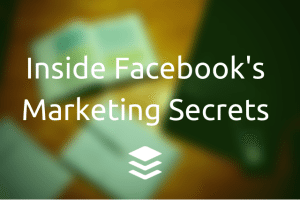
I’ve been fortunate enough to be a part of some amazing companies such as Facebook, Mint and now AppSumo.com (including our latest products: Monthly1k.com and SumoMe.com).
Collectively, these companies have reached nearly 1.5 billion people, and each has taught me many marketing methods that are extremely effective.
Here are the 10 most important marketing lessons I’ve learned along the way.
Lesson 1: Incentivize your audience (with something they want)
It’s not just any incentive that gets the job done. You should think in terms of offering the right kind of targeted promotions, partnerships or special access. Here’s what I mean:
Mint: Before Mint launched, we already had more traffic than all of our competitors (e.g. Wesabe or Quicken Online). We accomplished this by encouraging anyone who wanted early access to Mint to add a badge to their blog or website that said, “I want Mint,” or “My money’s on Mint.”

The result? Hundreds of bloggers in the personal finance space began to promote Mint. And because it was (and is) a great product, once they got access, they wrote positive reviews. Their readers were already curious about the product because they had seen the Mint badge and the branding.
AppSumo: At AppSumo we’re always doing giveaways. Our first giveaway (or contest) was gigantic. Anyone could submit their email address to enter to win one of 10 free DropBox Pro for Life accounts. If someone shared the giveaway and recruited friends, they got additional entries (and a greater chance to win).
By the end of the promotion, we had more than 50,000 email signups. Best of all, because this was before everyone knew about DropBox, the giveaway targeted the kind of customers that love AppSumo and the products we promote.
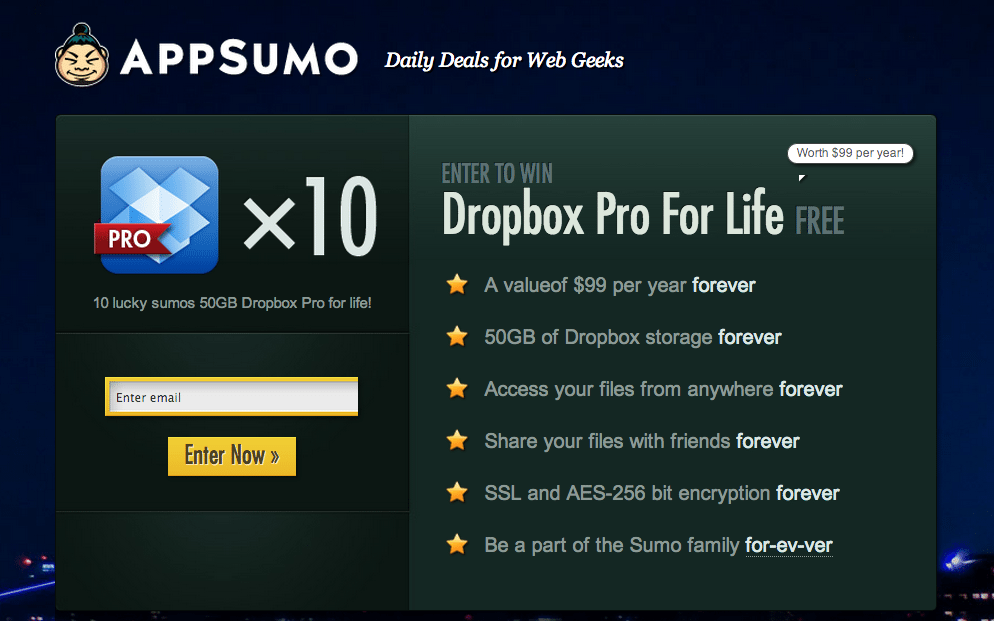
To incentivize your audience the same way, try:
- Creating a way to give special access or a special giveaway to those who share your product/service.
- Making sure people know what they get (or might get) and emphasize the value/scarcity.
- Finding another business to do cross-promotions with — this way you both get new exposure.
Lesson 2: Sponsor small neighbors
Often, the best sites are the up-and-comers; the sites that don’t even have any sponsors yet. You get a better relationship with the site owner and usually a quicker response time.
Mint: At the beginning we avoided large sites like TechCrunch and Lifehacker. Instead, we sponsored small personal finance blogs like
Bargaineering and tech startup sites like Paul Stamatiou. I was already reading a number of these sites, and we also used Technorati as a resource to find more.With Paul, we gave him early access to the product and he then shared his feedback publicly with his readers. (Read Paul’s first impressions of Mint here.)
AppSumo: We sponsored Tim Ferriss’ site fourhourworkweek.com and Andrew Chen’s blog. Again these guys had/have readers that we knew (and they knew) would benefit from what was being offered. Another great site we’ve been featured on is Pat Flynn’s Smart Passive Income. Most people in Silicon Valley have never heard of Pat, but his audience loves him. Our awareness on his blog has been awesome. (Thanks Pat!)
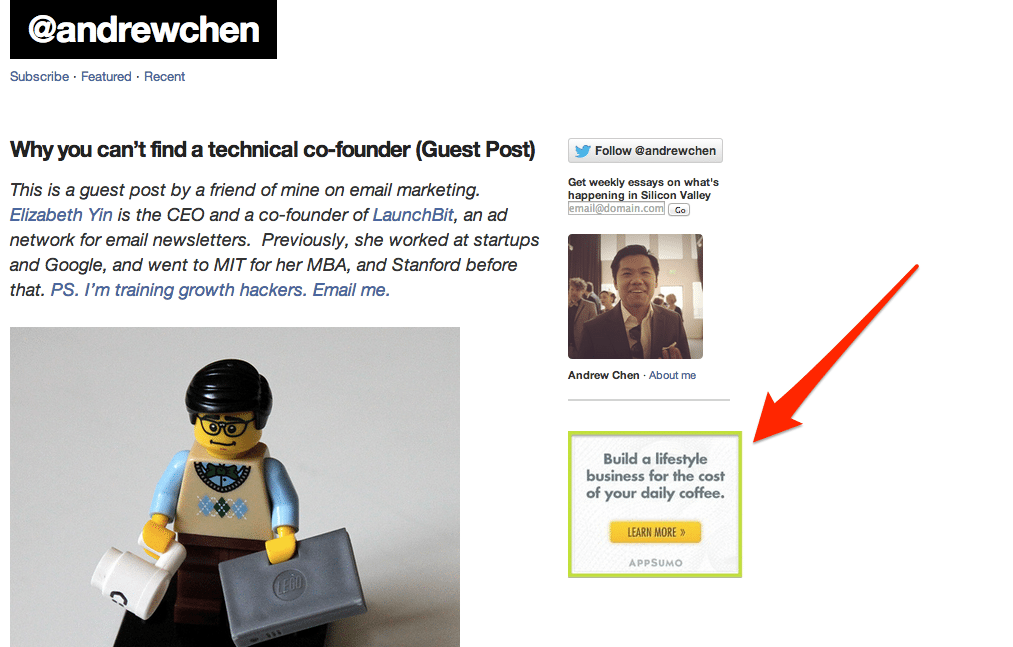
To find the right, small neighbors for your site:
- Use Buzzsumo (no official connection to AppSumo) to find what is resonating with your customers.
- Contact the creators and/or influencers sharing your posts about sponsoring their site(s).
- Survey current customers to find out what blogs and sites they visit in the niche you serve.
- Even if you don’t know a popular blogger or any blogger in your niche, emailing someone cold with the subject line “Sponsoring your site” is one of the highest open/response emails I have ever sent. Try it and see what happens.
Lesson 3: Listen to your audience and educate them
(Yes, this is the basic argument for all of content marketing…)
Mint: A site like Mint has to ask for very personal, secure information—namely login information for banks and credit cards. At Mint, we created a blog to really educate people about personal finance. By providing useful, educational content, we created more trust with our audience so people were able to more easily trust us.
By delivering useful articles that taught people simple and actionable tips about their finance, people trusted Mint and shared the content. It was never about the business or why Mint was best—it was about the reader and what she needed to know to improve her finance habits.

The blog also generated a ton of traffic. In addition to articles with actionable tips, we interviewed personal finance writers, including our own team, about their own finances. Here is an early interview from our first engineer’s personal finances.
AppSumo: Last spring we launched a new product (my personal favorite): the
How to Make $1,000 a Monthbusiness course
. At launch we emailed our 750,000+ email list. We assumed that everyone would drop what they were doing, and it would sell like hot cakes. After emailing the list numerous times, they still didn’t buy. (Keep in mind we were emailing many of our most loyal customers—people who have bought from AppSumo 10+ times.)Obviously this was a setback. So we started to listen to our audience’s fears and desires until we were able to more fully understand what held people back from buying. For example, we learned that people were most fearful that even if everyone else could start a business they couldn’t. Why? Not enough connections, or money, or time, or ideas….
To prove that anyone can start a business, I created a jerky business in less than 24 hours. (You can read the results here.) Instead of just telling someone about the course, I was able to show firsthand how it was done. To date, that was the #1 most effective way of selling the course.
To educate your audience about your product:
- Create content that helps people in their day-to-day lives. (At OkDork.com, we’ve focused on insanely actionable marketing content.)
- If you already have a successful content marketing plan in place, listen to what your customers are saying and asking to better tailor the content to your loyal customers.
- Start a drip or follow-up email sequence to educate new email subscribers about your product and company.
(For 17 more examples, check out Content Marketing Institute’s post about educating customers as a marketing strategy.)
Lesson 4: There’s massive opportunity in expanding internationally
There are 7 billion people worldwide. When you realize that America is less than 5 percent of the world population, you realize that the most powerful spending group is outside of this country.
Facebook: In 2013, Facebook reported that of its monthly active users, fewer than 20 percent come from the U.S. and Canada.
In response, Facebook localized the language for every country where the social network became available, propelling their international growth (this happened after I left). As a result, most of Facebook’s growth has been and will continue to be outside of the U.S.
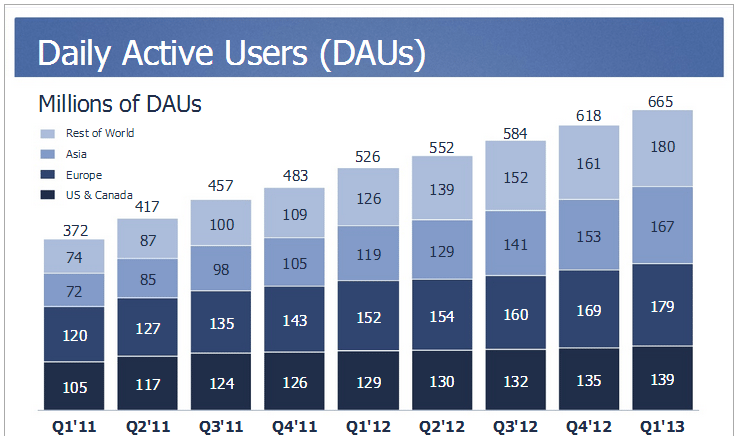
AppSumo: We’ve spent over $2 million in Facebook advertising at AppSumo. The majority of profitable ad spends were to international audiences. As the startup and entrepreneurial communities in other countries grow, we anticipate that our international sales will continue to grow. (If you are just getting started with advertising, feel free to read this primer on
spending your first $100 on Facebook ads.)Get started on expanding internationally:
- Find low barrier ways (like Facebook ads) to begin testing the international space.
- Unless you have someone on your team who is fluent in another language, start in English-speaking countries initially.
- Don’t wait, start testing. As you plan the next phase of your company, find ways to include international growth.
Lesson 5: Find your niche and validate early
Starting a business is all about validating an idea: Making sure the product solves people’s real problems.
Facebook: Zuckerberg began by creating a product that Harvard students could use and be fanatical about. Facebook then grew to other Ivy league schools and then college campuses. By limiting “The Facebook” to this group, he was able to create a product that college students loved and would talk about.
Mint: After surveying many potential verticals, we found that personal finance blog readers and early tech adopters were the hungriest for the product we were creating. We were able to validate the business with these groups and use them to drive the marketing.
AppSumo: Our niche was Silicon Valley tech startups. I started AppSumo because I needed and wanted the best tools possible to start my own business. Naturally, we focused almost exclusively on these startups and their employees. They hung out at Hacker News, so I spent time sponsoring sites that were commonly featured there.
Takeaways to validate your business:
- Start with a TINY group of people to be your first customers. Don’t worry about scale, yet.
- Focus on creating a product that a handful of people are truly fanatical about (like Buffer did with Hacker News.)
- Don’t start a business or spend money on marketing until you’ve found your first customers. Create a product they love before anything else.
Lesson 6: Design matters
Once you know your product works, investing in design is insanely valuable.
Facebook: At many organizations, design is looked down on—a designer would never be brought in as a high level advisor. But one of Mark Zuckerberg’s most trusted advisors was lead Facebook designer Aaron Sittig. Mark was very focused on all things design—to the point where he would email at 3 a.m. to ask why a period was hyperlinked. (If you want to read more about my FB experience, grab my free book here.)
Mint: The amazing Jason Putorti, our designer, was one of the key reasons people trusted us with their personal finance information. He created amazing, original landing pages (see them here). Same with the domain name. We ended up spending nearly $250,000+ to buy Mint.com instead of MyMint.com. Why? Mint.com created instant credibility and more trust with our customers.
AppSumo: We spent nearly $15,000 designing and optimizing the How to make a $1,000 a month business landing page. This product has helped thousands of people and investing in it has produced great results for us as well. Sometimes we even joke internally that it’s all about the landing page.
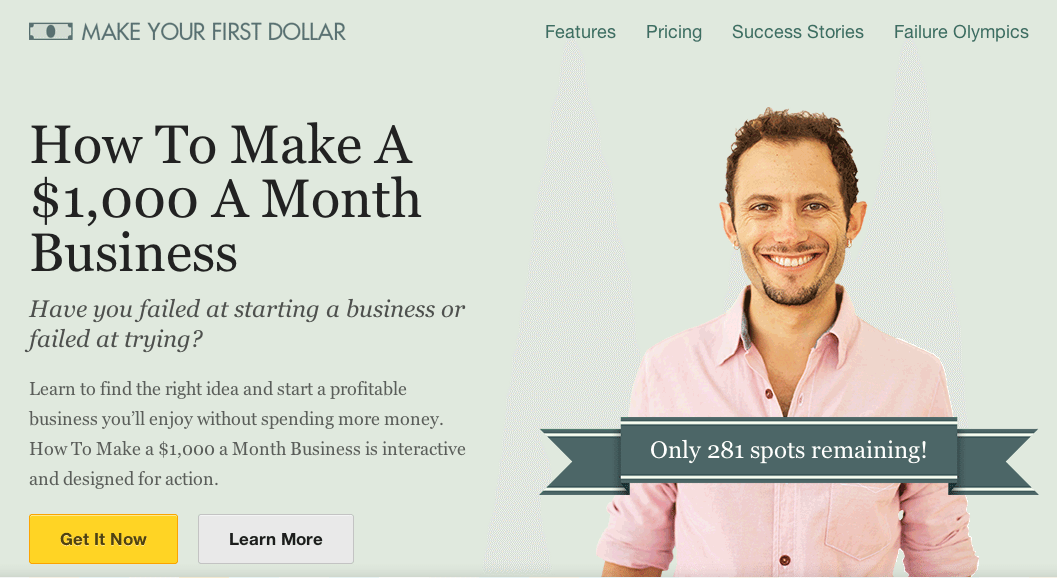
Keep in mind that good design does not equal complexity. Peep Laja, in a post about growing a blog, pointed out:
In a study by Google in August of 2012, researchers found that not only will users judge websites as beautiful or not within 1/50th – 1/20th of a second, but also that “visually complex” websites are consistently rated as less beautiful than their simpler counterparts.
Quick tips on creating a design focus:
- Create a checklist so your team always considers the design of a new page, product, or even stationary.
- Consider how design influences the trustworthiness of your brand.
- Don’t spend too much time or money on design until you have validated your idea and have a solid grasp on the needs of your customers.
Lesson 7: Repurpose your insider knowledge
What information and internal knowledge do you have that seems simple to you, but is valuable to others? That’s your insider knowledge, and it’s content marketing gold.
Facebook: Facebook previously had Pulse to show what’s latest on the site. Now it has Trending Topics, which tracks the most talked about topics and stories. Of course, they are taking a page from Twitter, which is one of the best examples of sharing insider knowledge. (For example, Twitter does a fantastic job of letting everyone know when the most tweets-per-second record is broken.)

Mint: We took our knowledge of trends/data to create PR around products that are selling well and published a ton of articles on TechCrunch and other places. We got press similar to this.
Recently Buzzsumo released an article on OkDork about what analyzing 100 million articles taught them about viral content. They shared the top 10 ingredients that viral posts had in common. The post met its own criteria and went viral on its own. By sharing their own data and findings they were able to attract a large number of new users that previously had not heard about their service.
Here are a few tips to unearth your insider knowledge:
- Keep track of larger trends in your data and research—turn this into additional content to win trust with customers and opportunities with press.
- Be willing to use data to show how you were wrong, how you pivoted, or how you validated your idea.
Lesson 8: Double down on what’s working
“If it ain’t broke, make it work harder.” (Click to Tweet)
Facebook: When Facebook realized that address book importing (and subsequently emailing those people) was a huge driver for new users, they added it to their on-boarding process. They then added almost every address book method possible (AIM, Gtalk, Skype, etc.). After that, Facebook even bought a company that does only address book importing. They could have stopped after adding it to the on-boarding process, but it was working so they made it work harder.
Mint: Mint started putting out infographics before they were even a thing. They gained significant traction on sites like Reddit and Digg. Then, because they drove SEO, Mint began putting out infographics almost once a week. Even today, infographics continue to drive a ton of traffic to the Mint blog.
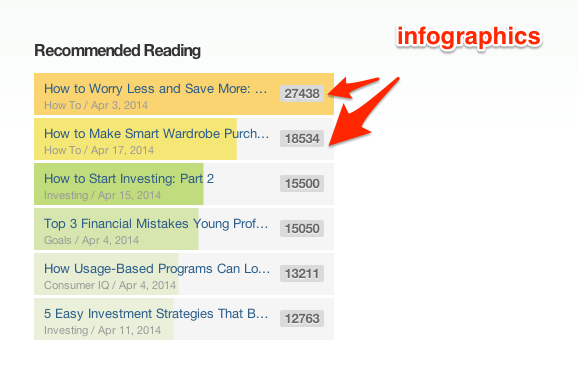
AppSumo: In our first month of advertising, we spent $400. Once we realized we made our money back, we spent $1,000 the next month. We kept increasing the ad spend until we peaked at $300,000/month. It can be easy to want to try new things, but be patient. Keep doing more of what works.
Try these tips to double down on success:
- Track what you are doing within your business.
- Focus on the actions that are getting real results.
- Regularly survey your best customers to find out more about their introduction to and experience with your company. As trends emerge, focus on these marketing methods.
Lesson 9: Get permission to talk to your customers
If you have a great service/product, reminding your visitors to come back (via email) is doing them a favor.
Facebook: When you first visit Facebook, the first thing they ask you for is your email address. Known as a “welcome gate,” this is essential to making your marketing work long-term. Unless you’re strict about your Facebook settings, chances are you get a handful of emails every week (or day) from Facebook.
Mint: Mint also requires that users sign up with their email addresses. They drive people back through weekly and monthly emails. For example, Mint created monthly financial statements that show a user their progress and the status of their accounts. This instantly reminds people of their goals and why they signed up with Mint in the first place.
AppSumo: We spent months promoting great products and had to spend a ton of time getting those same people to come back. Finally, Hiten Shah slapped me across the face and said to just ask for the person’s email. That singlehandedly changed our business forever.
We’ve even built a free tool SumoMe.com that gives anyone the exact tools we used to grow our email list.

Takeaways:
- Start collecting emails yesterday! Email is still the best way to stay in touch with your customers.
- You have to ask for their email address and you have to use it.
Lesson 10: Don’t assume what works for others will work for you, too
People assume that if they read enough, one day they’ll find the perfect solution to their own company’s dilemma, problem, need, etc. This may be the single biggest driver for every blog about marketing. While there is plenty to learn from others’ successes and failures, you will never find your exact solution from someone else. You have to find what works for you and your business.
Facebook: Even though it’s a staple of marketing, Facebook never did any content marketing. They relied on word-of-mouth, SEO and address book importing.
Mint: Mint grew mostly through SEO and by targeting small blogs in the personal finance community.
AppSumo: At AppSumo, we get almost no revenue from SEO. Most of our email subscribers come from promoting great products, free products (see Lesson 1), and advertising.
When it comes to your company:
- Each company has a plan that is the right fit; you’ll have to create your own.
- Create a marketing plan and do quantitative analysis to start to figure out which marketing will be most effective for your business.
- As you read articles and posts about successful companies, take what you can and apply it to your business—but don’t force a square peg in a round hole.
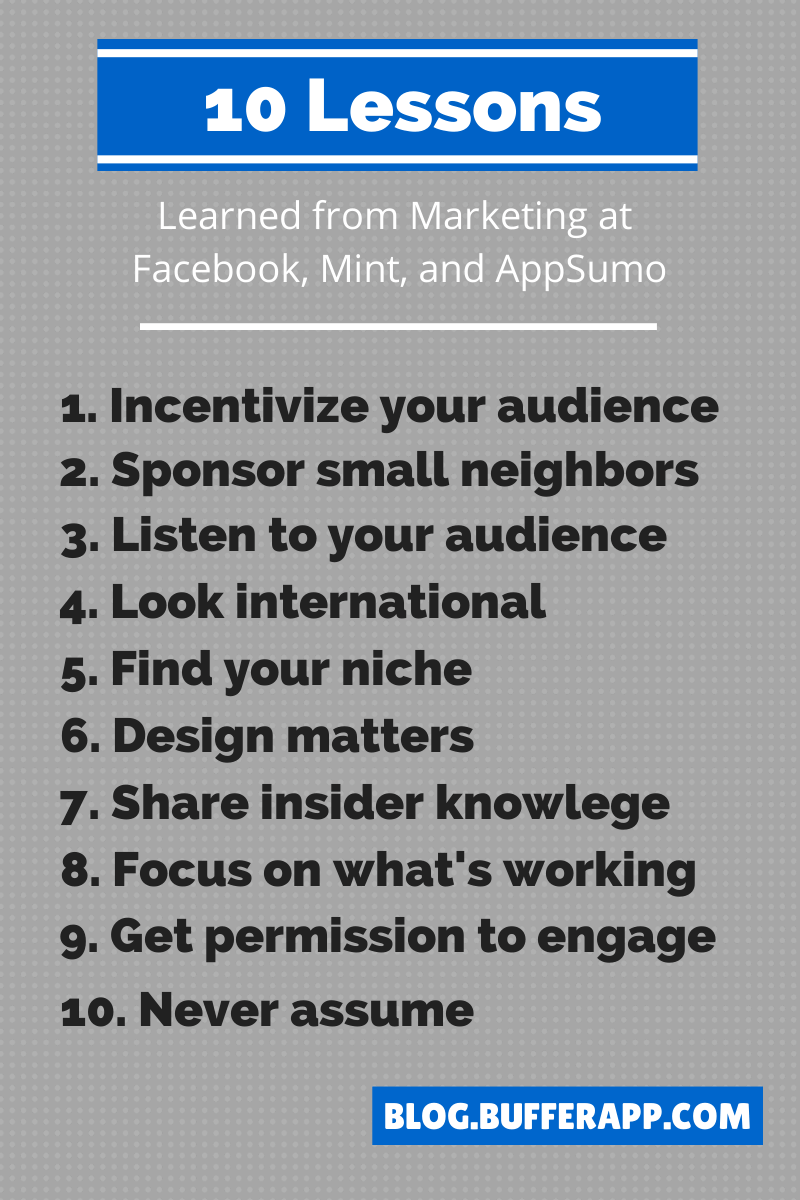
What marketing lessons have you learned during your career? Would you add anything to this list? I’d love to hear from you in the comments.
Thanks to Brian Dean, Nate Desmond, Tommy Walker, Paul Shapiro, Anuj Adhiya, Victor Pan and Tyler Vawser for reviewing this post!
Image credits: Svadilfari
Try Buffer for free
190,000+ creators, small businesses, and marketers use Buffer to grow their audiences every month.

